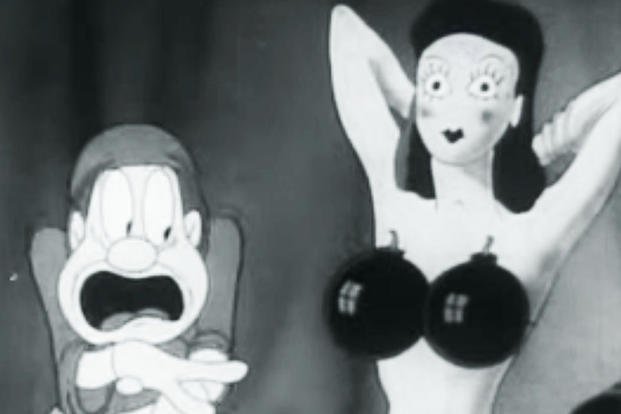Theodor Geisel wrote dozens of beloved children's books under his pen name of Dr. Seuss. "The Cat in the Hat," "Green Eggs and Ham," "How the Grinch Stole Christmas" and "The Lorax" are just the highlights from a collection that has remained popular for several generations.
Many people don't realize that the good doctor had a long and successful career as a commercial illustrator and political cartoonist before he became famous for his kids' literature. The Dartmouth College grad was approaching 40 when he joined the U.S. Army in 1943. He was put in command of the animation department of the 1st Motion Picture Unit, which was created out of the Army Signal Corps.
Geisel's commanding officer was Col. Frank Capra, chairman of the unit. Even though Capra is renowned for directing family-friendly movies like "It's a Wonderful Life," "Mr. Smith Goes to Washington" and "You Can't Take It With You," he created a soldier called Private Snafu to star in racy cartoons that would hold the attention of new recruits.
Private Snafu shorts were produced by an all-star team. Geisel wrote the shorts with a team that included children's authors P.D. Eastman ("Go, Dog, Go," "Are You My Mother?") and Munro Leaf ("Ferdinand the Bull"). The writers collaborated with Looney Tunes animators Chuck Jones, Friz Freleng, Bob Clampett and Frank Tashlin and voice actor Mel Blanc (Bugs Bunny, Yosemite Sam) to create a series of forgotten classics.
The team made 25 shorts for the War Department, although the last one was never released; it disappeared after the producers turned the master film over to the Army. There are also two post-war Snafu shorts made by a different group of writers and animators.
Anyone who thinks Dr. Seuss always had the best interests of the little ones at heart will be shocked to see Private Snafu in action. Check out these alarming examples.
1. Spies (director: Chuck Jones, 1943)
This episode offers a stern warning about excessive drinking and the dangers of hanging out with foreign women who are way out of your league. Plus, there are swastika boobs broadcasting Allied troop movements to Nazi headquarters.
2. Censored (director: Frank Tashlin, 1944)
Well, hang on. In this episode, we meet Snafu's girlfriend Sally Lou, a fetching young lady who reads his letters while not wearing a top or bra. Her strategically placed elbows keep the cartoon in PG-13 territory, but she's definitely a girl our hero is going to want waiting for him back home. That devotion to Sally Lou doesn't stop him from having topless pinups on the wall of his tent somewhere in the Pacific.
Oh yeah, this one's a warning about why military censorship of your letters home is both necessary and patriotic.
3. The Home Front (director: Frank Tashlin, 1943)
We open with a gag about the weather being so cold it would "freeze the nuts off a jeep;" cue actual lug nuts dropping off a jeep's wheels. While this joke will seem incredibly mild to a generation raised on "Two and a Half Men," there's zero chance that line would've been approved for actual home front presentation by the Hollywood Production Code office in 1943.
Once we pan inside the barracks, we see the walls covered with pinups who seem to be wearing fewer clothes than we'd see on the actual pinups that soldiers could acquire in real life. It's worth noting that director Frank Tashlin went on to direct live-action movies and made Jayne Mansfield a star in 1956 with "The Girl Can't Help It," a picture that featured Jayne in gowns that were technically covering everything but still managed to make her seem naked.
This episode addresses concerns about what may be going on back home and features grandpa watching barely clothed burlesque girls and a smooth, French-accented Jody turning into a bulging-eye wolf when he tells Sally Lou what big eyes she has, even though he's drooling as he stares at another part of her anatomy.
4. Booby Traps (Bob Clampett, 1944)
C'mon, you know where this is going because of the title. Of course, it starts with warnings about how to avoid getting blown up by bait left behind by a retreating enemy, but we get to the actual boobs and traps pretty quickly.
Let's just say these women are actual bombshells who have their own booby traps. This cartoon is also the first appearance of the Looney Tunes gag that features a character who plays "Believe Me, If All Those Endearing Young Charms" on a piano with a bomb switch connected to the last note's piano key. The joke was recycled for future Bugs Bunny and Roadrunner cartoons and never failed to deliver.
Since they were made by the government, all of these films are now in the public domain and you can watch them on YouTube. Back when they were made, however, they were kept under lock and key so they wouldn't corrupt young minds.
Dr. Seuss went on to write the screenplay and lyrics, plus design the sets for the incredibly weird 1953 movie musical "The 5,000 Fingers of Dr. T" before "Horton Hears a Who!" vaulted him into the upper tier of children's book authors in 1955.
There's sexism, racist imagery and immature jokes in all these cartoons that would never get Pentagon approval today. Still, these shorts educated and entertained millions of American service members during the era, and they offer a fascinating glimpse into the mindset and culture that won World War II.
Keep Up With the Best in Military Entertainment
Whether you're looking for news and entertainment, thinking of joining the military or keeping up with military life and benefits, Military.com has you covered. Subscribe to the Military.com newsletter to have military news, updates and resources delivered straight to your inbox.

















